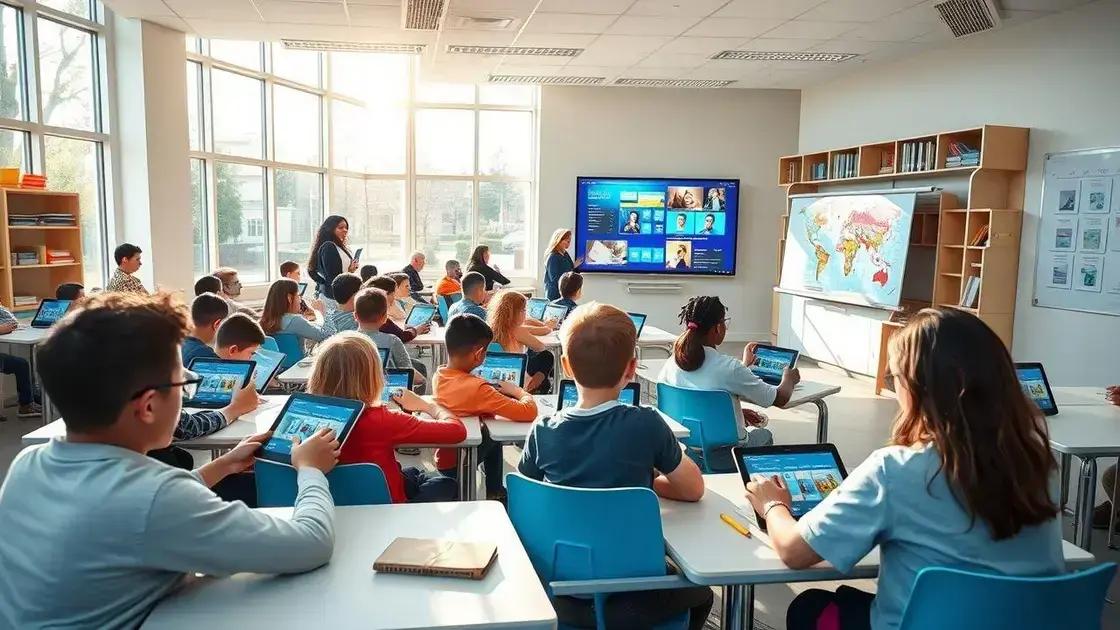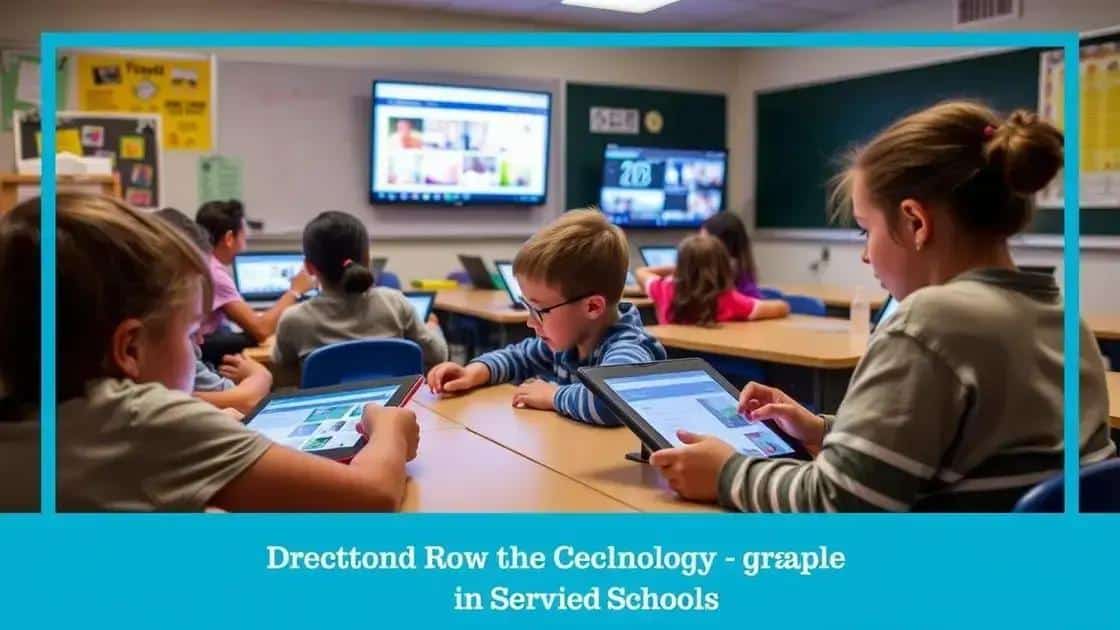Insights on school technology integration for better learning

Insights on school technology integration highlight its benefits, including enhanced engagement, improved collaboration, and access to diverse educational resources, all leading to a more effective learning environment.
Insights on school technology integration reveal exciting possibilities for enhancing student engagement and learning outcomes. Have you ever wondered how technology can transform the classroom experience? Let’s explore together.
Understanding the role of technology in education
Understanding the role of technology in education is essential in today’s digital age. Technology has transformed the traditional classroom into an engaging and interactive learning environment.
Interactive Learning Tools
One significant aspect of technology in education is the use of interactive learning tools. These tools foster collaboration and creativity, helping students grasp complex concepts easily.
- Online quizzes and assessments provide instant feedback.
- Interactive simulations make learning more immersive.
- Virtual classrooms connect students worldwide.
As educators embrace these advancements, they often find that students are more motivated and engaged in their studies. For example, gamification elements can turn learning into a fun challenge, rather than just a task.
Personalized Learning Experiences
Technology also allows for personalized learning experiences. With various educational software, teachers can tailor lessons to meet the unique needs of each student. This could mean adjusting the pacing of lessons or providing additional resources to those who need extra support.
A classroom equipped with technology can offer different learning styles and methods to cater to each student’s strengths and weaknesses. From video lessons to interactive activities, the possibilities are endless. Ensuring that students have access to these resources prepares them for a technology-driven world.
The Importance of Digital Literacy
In addition to the tools and personalized experiences, teaching digital literacy is crucial. Students must learn how to use technology responsibly and effectively. Skills like online research, digital communication, and critical thinking will help them navigate the challenges in today’s society.
As we explore the role of technology in education, it becomes clear that it’s about more than just introducing new tools. It’s about enhancing learning, fostering engagement, and preparing students for the future.
Benefits of technology integration in schools

The benefits of technology integration in schools are numerous and impactful. By embracing technology, educators can enhance learning experiences and improve student outcomes significantly.
Enhanced Engagement
One primary advantage is the increased engagement among students. When technology is integrated into the classroom, students are more interactive with learning materials. Digital tools, like videos and games, make lessons more dynamic and fun.
- Students become active participants in their learning.
- Gamifying lessons can boost motivation.
- Using multimedia enhances understanding of complex topics.
This engaging environment encourages students to explore topics deeply and ask questions, fostering a love for learning.
Improved Collaboration
Another significant benefit is improved collaboration. Technology allows students to work together seamlessly, whether they are in the same room or across the globe. Tools like online discussion boards and collaborative documents promote teamwork.
As students engage with peers, they learn valuable communication skills. This teamwork is essential for future career success. In this digital age, being able to collaborate effectively prepares them for real-life challenges.
Access to Resources
Additionally, technology integration provides access to a wide range of resources. Students can tap into online databases, e-books, and educational websites that enrich their learning.
This access allows them to find information quickly and helps develop research skills. The ability to utilize these resources effectively is crucial for developing knowledgeable, independent learners.
By integrating technology, schools can create an environment that supports innovation, creativity, and exploration. Students are equipped not only with academic knowledge but also with essential life skills that will serve them well beyond the classroom.
Challenges faced during tech integration
Challenges faced during tech integration in schools can hinder the effectiveness of new tools. Understanding these challenges is essential for successful implementation.
Resistance to Change
One significant challenge is the resistance to change from educators and staff. Many teachers are accustomed to traditional teaching methods and may hesitate to adopt new technologies.
- Fear of technology failure can cause reluctance.
- Some educators may lack confidence in their tech skills.
- Training and support are necessary to ease this transition.
Encouraging teachers through professional development can help overcome this resistance.
Insufficient Resources
Another challenge is insufficient resources for implementing technology. Schools often struggle with budget constraints, which may limit access to necessary hardware, software, and training.
Without adequate resources, teachers may not fully utilize tech tools or provide the best learning experiences for students. In many cases, it is essential to prioritize funding for technology to ensure all students benefit.
Tech Training and Support
A lack of ongoing training and support for educators can also pose a challenge. Technology is continually evolving, and teachers need continuous education to keep up.
Providing opportunities for teachers to learn about new tools and techniques ensures they can effectively integrate technology into their lessons. Support staff, such as tech specialists, can assist in troubleshooting issues and enhancing teacher confidence.
Understanding these challenges is vital for schools aiming to integrate technology successfully. By addressing resistance, ensuring adequate resources, and providing ongoing training, schools can create a more effective learning environment.
Strategies for effective technology adoption

Strategies for effective technology adoption in schools are essential to ensure that the integration process is smooth and beneficial for both teachers and students. Creating a structured plan can help maximize the impact of technology.
Start with Professional Development
One of the most important strategies is investing in professional development for educators. When teachers feel confident using technology, they can create engaging lessons for their students. Workshops and training sessions can help address the unique needs of each teacher.
- Offer regular training sessions on new tools.
- Encourage peer mentoring where experienced teachers help others.
- Facilitate online courses focusing on technology integration.
These ongoing learning opportunities ensure that teachers remain updated and skilled.
Set Clear Goals and Expectations
Another effective strategy is to establish clear goals and expectations for technology use in the classroom. Schools should define what success looks like and communicate these goals to all stakeholders.
This helps maintain focus on achieving desired outcomes, whether it’s improving student engagement or enhancing learning outcomes. Sharing these goals creates a shared vision within the school.
Involve All Stakeholders
Including all stakeholders in the process is vital. Administrators, teachers, students, and parents should be part of the conversation. Collaboration ensures that everyone’s needs and perspectives are considered, making the adoption process smoother.
Regular feedback can also help adjust strategies as needed. Gathering insights from students on their tech experiences can highlight areas for improvement.
By implementing these strategies, schools can create an environment that fosters successful technology adoption, ultimately leading to improved educational experiences for all.
In conclusion, integrating technology in education provides both challenges and opportunities. Schools can enhance learning experiences and improve engagement by adopting effective strategies. It’s essential to focus on professional development, set clear goals, and involve all stakeholders. As we embrace technology, we can create an enriched educational environment where students thrive. The future of education is bright, and technology is a key part of that vision.
FAQ – Frequently Asked Questions about Technology Integration in Schools
What are the main benefits of technology integration in education?
Technology integration enhances student engagement, improves collaboration, and provides access to a wealth of resources.
How can schools overcome resistance to technology adoption?
Schools can address resistance by offering professional development, showcasing success stories, and creating a supportive environment.
Why is involving stakeholders important during tech integration?
Involving stakeholders ensures diverse perspectives are considered, leading to more effective strategies and greater acceptance of new technology.
What resources are needed for successful technology integration?
Adequate funding, training for educators, and ongoing support are critical resources for successful technology integration in schools.





